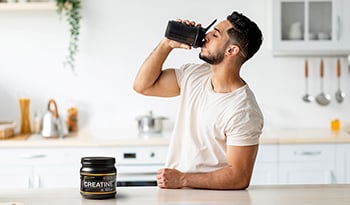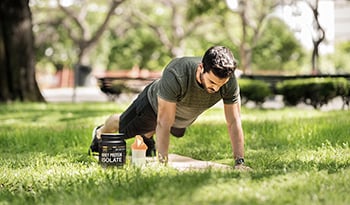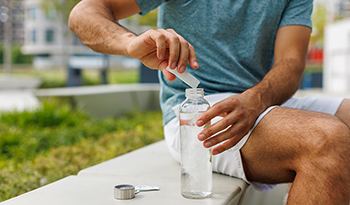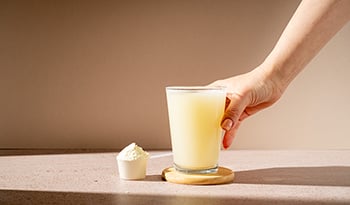Strength Training for Bone and Joint Health

Strength training is one of the best things people can do over their lifespans to promote strong bones and healthy joints. As we move through life, our bones and joints become more susceptible to age-related problems. Age-related bone loss, joint cartilage deterioration, and weakened muscles can all be a result of the natural aging process.
Strength training is accompanied by multiple benefits for every population and is arguably one of the best natural approaches to living a long, healthy life. Great strength training programs can be useful at any age to help improve bone and joint health. This is especially true for older populations that tend to experience age-related health problems at a rapid rate.
How Aging Affects Bones and Joints
Throughout the aging process, bones naturally begin to lose their strength and density. When we are younger, the bones have higher amounts of cells facilitating bone formation and an equal number of cells breaking down bones. However, this process shifts over time and bone formation slows down with age while bone resorption does not.
Bone resorption is the process in which bones are broken down into minerals by cells called osteoclasts and released into the body. In layman’s terms, the bones are breaking down faster than they are being built back up.
Research has suggested that we reach our peak levels of bone mass around the age of 20. As we surpass the age of 30, bone mass density typically begins to decrease. Generally speaking, research has suggested that this happens in the late 30s for women, and the early 40s for men. This process can also play a role in joint health; however, cartilage deteriorates at different individual rates based on everyday wear and tear.
This can sound extremely bleak, but there are ways to combat the natural aging progress with strength training, proper nutrition, and strategic supplementation. The best part is that no matter your age, you can start them today and reap their benefits.
How Strength Training Directly Supports Bone Health
Progressive overload in exercise leads to bone adaptation—meaning that strength training briefly deforms bones to a minimal degree following a workout, which then triggers cells called mechanosensors throughout the body. These mechanosensors create a biochemical response to the stresses placed upon the bones from training.
These biochemical responses result in bone formation and growth at the deformed sites. So, the stress strength training produces is actually useful because it promotes specific bone-related anabolic biochemical responses that would not have been present otherwise. That’s why strength training is so important in older populations who already have limited or decreasing osteoblast levels.
In addition to improving bone health, strength training has also been associated with lower risks of bone fractures in older populations due to falling as well as improved joint mobility. These two benefits can be attributed to the progressive overload on the body through multiple planes of motion.
Supplements for Bone and Joint Health
Outside of the physical aspects of strength training, a few supplements have also been shown to potentially support and improve bone and joint health.
Collagen
Collagen, the most abundant protein in the body, has been suggested to play a role in improving bone mineral density. The bones are constructed mostly of collagen, so supplementing with it may be useful for promoting bone mineral density. This can be slightly more useful for populations who may be experiencing age-related bone loss.
MSM
Methylsulfonylmethane (MSM) may play a role in the inflammatory response that can follow exercise, which may result in joint pain relief. In older populations, workouts can add additional stress to joints that lack ample cartilage, and experience slightly more friction. MSM can be useful in supporting the body’s ability to decrease acute amount of inflammation following strength training.
Glucosamine and Chondroitin
Glucosamine and Chondroitin are supplements that have been shown to potentially decrease joint stiffness and improve joint comfort levels. In older populations or in colder weather climates, joint stiffness can cause daily discomfort. While research is still slightly thin on this supplement, some studies have demonstrated a decrease in overall stiffness in joints.
Vitamin D
Vitamin D—or the sunshine vitamin—can be a useful supplement for supporting overall bone health. This vitamin plays a large role in calcium absorption and bone mineralization, which are two areas that can cause joint problems when not adequately present⁶. Vitamin D is typically recommended to be taken in winter months and for older populations who may be lacking the ability to get outside and obtain enough Vitamin D naturally, through the sun.
As we age, bones and joints can deteriorate due to daily wear and tear. Strength training—along with proper nutrition and supplementation—is one the best natural approaches to not only combating but also potentially improving bone health throughout our lifespans.
References:
- Santos, L., Elliott-Sale, K., & Sale, C. (2017). Exercise and bone health across the lifespan. Biogerontology, 18(6), 931-946. doi:10.1007/s10522-017-9732-6
- Latham, N., & Liu, C. (2010). Strength Training in Older Adults: The Benefits for Osteoarthritis. Clinics In Geriatric Medicine, 26(3), 445-459. doi:10.1016/j.cger.2010.03.006
- König, D., Oesser, S., Scharla, S., Zdzieblik, D., & Gollhofer, A. (2018). Specific Collagen Peptides Improve Bone Mineral Density and Bone Markers in Postmenopausal Women—A Randomized Controlled Study. Nutrients, 10(1), 97. doi:10.3390/nu10010097
- Withee, E., Tippens, K., Dehen, R., Tibbitts, D., Hanes, D., & Zwickey, H. (2017). Effects of Methylsulfonylmethane (MSM) on exercise-induced oxidative stress, muscle damage, and pain following a half-marathon: a double-blind, randomized, placebo-controlled trial. Journal Of The International Society Of Sports Nutrition, 14(1). doi:10.1186/s12970-017-0181-z
- Vasiliadis, H., & Tsikopoulos, K. (2017). Glucosamine and chondroitin for the treatment of osteoarthritis. World Journal Of Orthopedics, 8(1), 1. doi:10.5312/wjo.v8.i1.1
DISCLAIMER:This Wellness Hub does not intend to provide diagnosis...



























































































